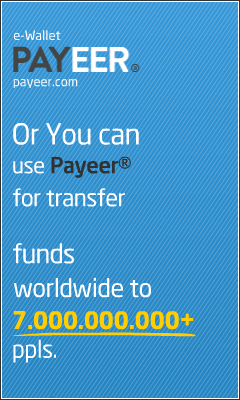Jobs: Mom Makes $6762 a Month at Home
As part of our continued series: "Employment and the Recession: What Do We Need To Know" we research an industry that is booming, in spite of a Recession. Filed by Tina Lewis under Finance.
Many of these online workers are making as much as $300 a day working part time online using nothing but their internet connection and home computer.
Kim Barnes is a regular mom who lost her job last year, after an unsuccessful job hunt she started working online from home. I interviewed her about her amazing story and she revealed her steps for success.
Step 1
Go to this link, fill out a basic online form and hit submit at Web Profit Club (Better Business Bureau A+ Accredited), pay the $1.97 for the shipping.
Step 2
Follow the directions and set up an account. Then they will give you the website links to post. Start posting those links. They track everything.
Step 3
You will receive your first checks in about a week. Or you can have them wire directly into your checking account. (Your first checks will be about $500 to $1,500 a week. Then it goes up from there. It depends on how many links you posted online.)
Have You Ever Considered Working Online?
Kim Barnes of , never thought that she would consider it, until curiosity got the best of her and she filled out a simple online form. Before she knew it, she discovered her secret to beating the recession, and being able to provide for her family while at home with her three children.
I read Kim's blog last month and decided to feature her story in our weekly consumer report. In our phone interview she told me her amazing story. "I actually make about $5,000-$7,000 a month working from home. It's enough to comfortably replace my old job income, especially considering I only work about 15-18 hours a week from home right now.
Working online has been a financial windfall for Kim, who struggled for months to find a decent job but kept hitting dead ends. "I lost my job shortly after the recession hit, I needed reliable income, I was not interested in the "get rich quick" scams you see all over the internet. Those are all pyramid schemes. I just needed a legitimate way to earn a living for me and my family. The best part of working online is that I am always home with the kids, I save a lot of money."
"I actually make $5,000 to $7,000 a month working from home."
- Kim Barnes
I asked her about how she started her remarkable journey. "It was pretty easy, I filled out a short form and applied for a work at home kit. There is a small shipping and handling fee, its not really free but it was under $5. I got the Kit and within four weeks I was making over $5,000 a month. It's really simple, I am not a computer whiz, but I can use the internet. I post links that are given to me, I don't even have to sell anything and nobody has to buy anything. They are constantly recruiting people to post links, you should try it." There are over 350 positions available just for at the time of this report.
These online social giants are worth well over 100 billion dollars and growing. They are the most used social networking and meeting places on the web today and growing faster and faster. These companies have just started hiring people to work at home to keep up with the demand. Why not get in with the internets best and biggest companies.
Now, there are plenty of scams on the internet claiming you can make $50,000 a month, but that is exactly what they are scams. From my conversation with Kim, "I am making a good salary from home, which is amazing, under a year ago I was jobless in a horrible economy. I thank god every day that I filled out that form."
Quickly, Kelly Richards was able to use the simple Web Profit Club to make it out of the recession.
"I have never told anyone they will make millions of dollars. Instead, I believe this is the only site that tells you won't make millions, but you can make legitimate income from home like I did and replace your full time job."
Getting started is easy. Just follow these simple steps below to get started.
Step 1
Go to this link, fill out a basic online form and hit submit at Web Profit Club (BBB A+ Rated), pay the $1.97 for the starter kit.
Step 2
Follow the directions and set up an account. Then they will give you the website links to post. Start posting those links. They track everything.
Step 3
You will receive your first check in about a week. Or you can start to have them wire directly into your checking account. (Your first checks will be about $500 to $1,500 a week. Then it goes up from there. It depends on how many links you posted online.)
Kim stressed the importance of using both kits.
Related links:
Web Profit Club (BBB A+ Rated) - Official Website
Comments (17)
Comments for: "Mom Makes $6800 Working Online at Home?"
Shane Says: 10:47AM
I saw this on TV and how she did this. She was very fortunate to have found this out.
Johnny Says: 6:17PM
Just FYI on this deal here. You have to have some computer skills, at least be able to use email and such. Then you will be ok.
Tim Says: 2:34PM
I was laid off as well and I am hoping this could be a big help right now.
Dianna Says: 5:21AM
Thanks Kim, I started a few weeks ago and already got my first checks totaling $1800, cool.
Bob Says: 11:45AM
I already got my kit and tried it out. It works with all the internet giants and I was able to make about $500 a week right from the start. I am working right now to double my efforts and my money I hope. It's easy work but you have to have a good internet connection.
Joey Says: 9:52PM
could this be for real? I tried some other thing online and it didn't work out that well for me. I think I made about $400 a month but that was years ago. I know the internet giants is making money so I will give it a try.
Dana Says: 4:43PM
I hope so too! I am not the best when it comes to computers but, I can do email and surf, I think I can post links!!!!
Janet Says: 10:23PM
Holy molly! thanks for the post with screen shot! you just gave me the inspiration I needed. Thanks!
Molly Says: 3:03AM
Ok, I'm using it right now and it is doing pretty well actually. it cost about $2 dollars for shipping, it came in a few days and I have been doing good ever since. on my first week I was able to make a big $270 but on the second week I doubled it. it's now rolling along at $300+ a day! I'm gonna keep going and see how much I can make going full time at it.
Ted Says: 11:44AM
is someone using this now? very interesting....
Tina Says: 12:36PM
I just wanted to tell everyone I got my first check today for $2800!
Jim Says: 1:35PM
ok, very interesting......I really could use something like this.
Tony Says: 2:18AM
Yeah, I did just join. I am working on it when my computer
crashed so I had to borrow a friends laptop... but, all is good now so I will post back
how it goes!
Kimberly Says: 4:41PM
I did it and I even got my husband helping me in the evenings! We just want to make enough
to pay of the debt and stop the phone from ringing at dinner! At this rate we should be feeling
major relief by this week.
Gean Says: 9:04PM
thats sad.....I almost lost my house but, ended up with a job. I just signed up for this so I'm hoping it works.
Danny Says: 1:41AM
i'm only 17 years and I signed up and having some good success. I found this is the best way to make money using the internet.
Jerome Says: 1:06PM
does this really work???????????? I mean the whole working at home stuff? is anyone making money? I guess for $4.95 i will try it out.
Kathy Says: 4:52PM
Jerome: you have to work and use the computer and internet, and if you can do that and dedicate some time each day then you can do this with no problem.
I have been working with this for a month and have made over 5k already. let me know if you need more help.
http://aliney.info/
喬布斯:媽媽讓六千七百六十二美元每月至少首頁
的一部 分,我們將繼續系列:“就業和經濟衰退:我們為什麼需要知道”我們研究的行業正在蓬勃發展,儘管經濟衰退。蒂 娜劉易斯提交的融資。
許多工人都在這些在線高達 300天的工作時間在網上使用的部分只是其互聯網連接和家用電腦。
金巴恩斯是一個普通的媽媽誰失去了工作的最後一年,找工作失敗後,她開始在家裡上網工作。我 採訪了她對她的神奇故事,她發現她的腳步成功。
第 1步
去這個網站,填寫了一個基本的在線表單提交網站和命中利潤會(更好的商業局A 認證),支付1.97美元的運費。
第2步
按照指示,並成立一個帳戶。然後,他們會給你的網站的鏈接張貼。開始張貼這些鏈接。他們跟踪一切。
第3步
您將收到您的第一個檢查,一個星期 左右。或者你可以讓他們直接將電線您的支票帳戶。 (您先檢 查將約為 500美元至1500美元的一周。然後從那裡去。這要看你多少鏈接發布到網上。)
你有沒有想過在線工作?
金 巴恩斯的,沒想到她會考慮它,直到有最好的好奇心,她和她填寫了一份簡單的在線表格。在她知道,她發現她的 秘密跳動經濟衰退,並能夠提供在家時她的家人和她的三個孩子。
我讀了金正日的博客上個月決定將她的故事在我們的專題每週消費者報告。在我們的電話採訪 時她告訴我她的神奇故事。 “我實際上使約 5,000 - 7,000元,每月在家工作。這足以取代我原來的工作輕鬆收入,特別是考慮到我只工作約 15-18小時,每週從家裡現在。
聯機工作一直是意外的收穫金正日,誰奮鬥了幾個月找到一份體面的工作,但不停地打死角。 “我失去了我的工作後不久,經濟不景氣,我需要可靠的收入,我不感興趣的”快速致富“騙局你可以看到所有在互聯網上。這些都是傳銷。我 只是需要一個合法途徑賺取生活對我和我的家人。最好的部分工作在網上,我總是和孩子們回家,我節省了很多 錢。“
“我實際上使5,000元至7,000元,每月在家工 作。”
- 金巴恩斯
我問她關於她如何開始她不平凡的旅程。 “這是很容易的,我填寫了 一份簡短表格,申請了在家工作包。有一個小的運輸和裝卸費,那不是真正的自由,但它是根據 5美元。我得到了工具包,並在四個星期我製作超過每月5,000元。這很簡單,我不是電腦高手,但我可以使用互聯網。張貼鏈接,是給我,我什至沒有出售任何東西,沒有人買任 何東西。它們不斷招聘的人的鏈接後,你應該嘗試一下。“有超 過 350個職位空缺只是在當時的這份報告。
這些都是值得的在線 社交巨頭超過 100億美元,增長。他們是最常用的社交聚會場所和今天在網絡上越來越快。這些公司僱用人員,剛開始在家工作跟上需求。為什麼不與因特網和最好和最大的公司。
現在,有很多騙局在互聯網上聲稱你可以每個月 50,000美元,但正是他們都是騙局。從 我的談話與金,“我正在做一個良好的薪金從家裡,這是驚人的,在一年以前,我又失業了可怕的經濟。我感謝上帝,我每天都填寫的表格。”
很快,凱利理查茲能夠使用簡單的網絡,使其利潤會走出衰退。
“我從來沒有告訴過任何人,他們將數百萬美元。相反,我認為這是唯一的網站,告訴你不會賺幾百萬,但你可以從家裡合法收入和我一樣, 並取代您的全職工作。”
開始使用非常容易。只要按照這些簡單的步驟即可開始使用。
第1步
去這個網站,填寫了一個基本的在線表單提交網站和命中利 潤俱樂部(BBB級 A額定),支付1.97美元的入門工具包。
第 2步
按照指示,並成立一個帳戶。然 後,他們會給你的網站的鏈接張貼。開始張貼這些鏈接。他們跟 踪一切。
第3步
您將收到您先檢查在一個星期左右。或者你也可以將它們連接線直接到 你的支票帳戶。 (您先檢查將約為 500美元至1500美元的一周。然後從那裡去。這要看你多少鏈接發布到網上。)
金正日強調,使用這兩種試劑盒的重要性。
相關鏈接:
網站盈利俱樂部 (BBB級 A額定) - 官方網站
評論(17)
評論為:“媽媽讓 $ 6800聯機工作在家嗎?”
謝恩說:上午10時 47分
我看見她在電視和如何這樣做。她很幸運地發現了這一點。
強 尼說:下午6時 17
僅供參考這個活動在這裡。你必須有一定的電腦技能,至少能使用電子郵件等。然後你會沒事的。
Tim說:下午2點 34分
我被裁員好,我 希望這可能是一個很大的幫助現在。
厄納說:上午 05點 21
謝謝金,我開始了幾個星期前,已經得到了我的第一次 檢查共計 1800元,涼。
鮑 勃說:上午11點 45分
我已經得到了我的工具包,並試圖出來。它與所有的互聯網巨頭,我能做出一個星期500美元從一開始。我的工作現在我加倍努 力,我的錢,我的希望。這是簡單的工作,但你必須有一個良好的互聯網連接。
喬伊說:下午9時 52分
可這是真的嗎?我嘗試了一些其他東西線上,並沒有制定出對我那麼好。我想我每月400美元左右,但是 那是很多年前。我知道互聯網巨頭都賺錢,所以我給它一個嘗試。
達納說:下午4時 43分
我也希望如此!我不是最好的當涉及到計算機,但是,我能做的電子郵件和網上衝浪,我想我可以留言聯繫!!
珍妮特說:下午10點 23分
聖莫莉!感謝您的文章與屏幕的射門!你給我的靈感我需要的。謝謝!
莫莉說:上午3時 03
好吧,我現在使用它,它其實是做得很好。它的成本約 2美元的運費,當時他們在幾天我一直在做好事至今。我的第一個星期我能夠 做一個大270元,但在第二個星期,我翻倍了。它現在沿軋製 300元一天!我要堅持下去,看看有多少我可以去全職它。
泰德說:上午11時 44分
這是有人使用了 嗎?非常有趣的....
蒂娜說:下午12:36
我 只是想告訴大家,我得到了我今天先檢查 $ 2800!
吉姆說:下午1時 35分
好, 非常有趣的......我真的很需要這樣的東西。
托 尼說:上午02點 18分
是啊,我剛剛加入。我工作的是當我的電腦
崩潰,所以我不得不 借用一個朋友的筆記本電腦 ...但是,一切都不錯了,所以我會回
怎麼一回事呢!
金伯利說: 下午4時 41分
我做到了,我什至幫我得到了我的丈夫在晚上!我們只是想製造足夠的
支付的債務和停止振 鈴電話晚餐!在這個速度,我們應該感覺
本週主要救濟。
傑安說:下午九時 04分
這 就是悲傷 .....我幾乎失去了我的房子,但最多的一個工作。我只是簽署了這個,所以 我希望它的作品。
丹尼說:上午01時 41分
我只有17歲,我註冊了,並有一些很好的成功。我發現這是最好的賺錢方式使用互聯網。
杰羅姆說:下午1點 06分
這是否真正的工 作????????????我指的是整個工作在家裡的東西?有沒有人賺錢嗎?我想為 4.95美元,我會嘗試一下。
凱西說:下午4時 52
杰 羅姆:你有工作,使用電腦和互聯網,如果你能做到這一點,每天花一些時間,那麼你可以做到這一點沒有問題。
我一直在使用這一個月,已經取得了超過 5公里。讓我知道如果你需要更多的幫助。
http://aliney.info/
FlashVars="autoPlay=true".


















